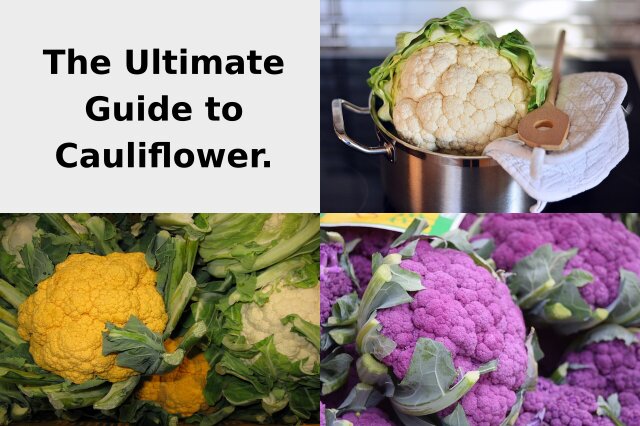Cauliflower is a nutrient-packed cruciferous vegetable that has a mild taste and can be cooked in many different ways.
From roasting to air frying, it’s an incredibly versatile vegetable that is deliciously savoury and nutritious.
In this guide, you’ll learn the health benefits of cauliflower, different types, how to cook it in many different ways, and try some delicious recipes.
What is Cauliflower?
A Comprehensive Guide.

Cauliflower is a versatile and delicious vegetable that can be enjoyed in many different ways.
In this comprehensive guide, you will learn everything you need to know about cauliflower, including its nutritional benefits, different ways to cook it, and how to store it.
You will also find recipes for cauliflower dishes that are sure to please everyone at the table.
So whether you are a cauliflower lover or you are just getting started, this guide has something for you. Read on to learn more about this amazing vegetable!
What is Cauliflower?
Cauliflower is a cruciferous vegetable that belongs to the same family as broccoli, kale, collards, and Brussels sprouts.
It has an edible head that consists of soft and fleshy white florets, which are surrounded by leaves.
Cauliflower can be eaten fresh or cooked in various dishes and it maintains its nutritional benefits regardless of how it’s cooked.
Nutritional Benefits of Cauliflower
Cauliflower is an excellent source of vitamin C, containing 77% of the recommended daily allowance in a serving.
It’s also rich in other important vitamins and minerals such as folate, manganese, potassium and phosphorus.
Additionally, it provides dietary fibre and protein.
Cauliflower is low in fat and calories but packed with antioxidants that provide health benefits like disease prevention and improved immunity.
Cauliflower is a carb, although it’s low in calories, it’s high in carbohydrates.
One cup of raw cauliflower contains 5 grams of carbs, 3 grams of dietary fibre and 2 grams of sugar.
Fun Facts About Cauliflower
As mentioned, cauliflower is part of the ‘cruciferous vegetable’ family, meaning it contains sulfur compounds that provide an array of amazing nutritional benefits.
It’s also a great source of fibre and high in Vitamin C and K.
Furthermore, cauliflower comes in many different varieties such as white, purple and orange versions.
Cauliflower leaves are edible! They have a delicate, but bitter flavour and can be cooked like any other green vegetable – steamed, boiled, stir-fried or as an ingredient in soups or stews.
The leaves are also rich in nutrition, providing you with vitamin A, B12 and K.
So impress your friends with these fun facts and enjoy adding this veggie to all your favourite dishes!
5 Common Types of Cauliflower.
Did you know there are different types of cauliflower? From purple to orange, learn about the five common types of cauliflower and their unique flavors.
There are actually hundreds of varieties of cauliflower that come in various colours with white cauliflower being the most popular.
The five main groups of cauliflower are:
- White Cauliflower.
 White cauliflower is the most common variety of cauliflower and is what most people think of when they hear the word “cauliflower.”
White cauliflower is the most common variety of cauliflower and is what most people think of when they hear the word “cauliflower.”
It has a mild, nutty flavour and a firm, dense texture.It is a great source of vitamin C, vitamin K, folate, and fibre.
It also contains antioxidants and has been linked to reducing the risk of certain types of cancer.However, green cauliflower (also known as broccoflower) is also a healthy option and contains even more nutrients than white cauliflower.
- Green Cauliflower.
 Green cauliflower can also be referred to as a broccoflower.
Green cauliflower can also be referred to as a broccoflower.
This cauliflower looks like a typical cauliflower but has the colour of broccoli, it is similar to broccoli in their texture and are more fibrous..
Green cauliflowers tend to have a sweeter and milder taste than the white cauli.Green cauliflower is just as healthy as regular cauliflower, if not more so.
It contains the same nutrients as white cauliflower, such as vitamin C, fibre, and antioxidants, but also has the added benefit of chlorophyll, which has been linked to improved digestion and detoxification.- Orange Cauliflower.
 Orange cauliflower is a relatively new variety of cauliflower.
Orange cauliflower is a relatively new variety of cauliflower.
It has a slightly sweeter flavour than white cauliflower and a tender texture.Orange cauliflower is just as healthy as regular white cauliflower.
It contains the same nutrients, such as vitamin C, fiber, and antioxidants.The only difference is that orange cauliflower contains more beta-carotene, which gives it its vibrant colour.
Beta-carotene is converted into vitamin A in the body, which is important for eye health and immune function.- Purple Cauliflower.
 Purple cauliflower is a unique and visually striking variety of cauliflower.
Purple cauliflower is a unique and visually striking variety of cauliflower.
It has a vibrant purple colour and has a slightly sweeter flavour than white cauliflower and a tender texture.It contains many of the same nutrients as regular white cauliflower, such as fibre, vitamin C, and vitamin K.
Additionally, the purple color comes from anthocyanins, which are powerful antioxidants that may have anti-inflammatory and cancer-fighting properties.
- Romanesco Cauliflower.
 Romanesco cauliflower, also known as Romanesco broccoli or Roman cauliflower, is a visually stunning variety of cauliflower that has a unique, fractal-like appearance. It has a mild, nutty flavour and a slightly firmer texture than white cauliflower.
Romanesco cauliflower, also known as Romanesco broccoli or Roman cauliflower, is a visually stunning variety of cauliflower that has a unique, fractal-like appearance. It has a mild, nutty flavour and a slightly firmer texture than white cauliflower.
Romanesco cauliflower is considered a healthy vegetable. It is high in fibre, vitamin C, vitamin K, and potassium.
It also contains antioxidants and has anti-inflammatory properties.
Some even consider it a superfood due to its nutritional benefits.
6 Ways To Cook Cauliflower.
It is a versatile vegetable that can be cooked in a variety of ways. It can be roasted, steamed, boiled, air fried or microwaved.
Roasting and air-frying cauliflower brings out its natural sweetness and gives it a crispy texture, while steaming, cooking in the microwave or boiling it helps retain its nutrients.
Experiment with different cooking methods to find your favourite way to enjoy this nutritious vegetable.
Ingredients
- 1 cauliflower
- water
- salt
Instructions
- Prepare Cauliflower for Cooking.
- Rinse the cauliflower thoroughly under cold running water to remove any dirt or debris.
- Cut off the leaves and trim the stem so that the cauliflower sits flat on a cutting board.
- Cut the cauliflower into florets by slicing through the stem and separating the head into bite-sized pieces.
- How to Roast Cauliflower
One of the easiest methods is by roasting it.
If you’re looking for an easy, delicious way to cook cauliflower, look no further!
Roasting cauliflower brings out its natural sweetness and enhances its nutty flavour.
It also gives it a crispy texture on the outside while keeping it tender on the inside.
Plus, it's a simple and easy way to prepare cauliflower that requires minimal effort and yields delicious results.
Follow this step-by-step guide on how to roast cauliflower and become an expert in no time. - Preheat the oven to 200°C/400°F.
- Line a baking sheet with parchment paper.
- Cut the florets into bite-sized pieces and spread them onto the baking sheet.
- Drizzle with oil, season with salt and pepper, and toss to coat evenly.
- Roast for 20 minutes then remove from the oven and enjoy!
- How to Steam Cauliflower
Elevate your everyday cooking skills with this step-by-step guide on how to steam cauliflower properly—leaving you with delicious and healthy results every time!
Steaming cauliflower is a great way to preserve its nutrients and flavor.
It also helps to soften the cauliflower without making it mushy, making it easier to eat and digest.
Additionally, steaming cauliflower is a healthier cooking method as it doesn't require added oils or fats. - Steaming in a Pan
This is the most common way steam cauliflower.
It results in great tasting cauliflower. - Bring about 6cm (¼") of water to a boil in a large frying pan.
- Add about ½ teaspoon salt and the trimmed and cleaned cauliflower florets.
- Cover the pan and steam until as tender as you like (about 3 minutes for crisp-tender and up to 8 minutes for completely cooked, soft florets).
- Make sure to drain any water from cauliflower before using.
- Steaming in a Steamer Basket
This is a classic method of steaming vegetables.
The cauliflower is placed in a steamer basket or an insert over boiling water. - Bring about 2.5 cm (1") of water to a boil in the bottom of a pot into which your steamer basket or insert fits.
- Put trimmed and cleaned cauliflower florets in the steamer basket and set the basket over the boiling water.
- Cover the pot and steam until the cauliflower is tender to the bite, about 3 minutes for crisp-tender and up to to 8 minutes for fully tender florets.
- How to Boil Cauliflower.
Boiling cauliflower on the stove is simple with this foolproof method.
Boiling cauliflower is a common cooking method that helps to soften the vegetable and make it more tender.
It can also help to remove any bitterness from the cauliflower.
Additionally, it can make it easier to mash or puree for use in recipes like cauliflower soup or mashed cauliflower.
Here's our step-by-step instructions to enjoy delicious and nutritious dishes. - Place trimmed and cleaned cauliflower florets in a large pot.
- Fill pot with water so that florets are covered.
- Add 1 tsp salt.
- Bring to boil.
- Reduce heat and simmer for for 5-7 minutes.
- How to Fry Cauliflower
Cauliflower is a versatile vegetable that can be transformed into a crispy and flavourful snack.
Follow these simple steps to fry cauliflower to perfection.
Fried cauliflower has become a popular alternative to chicken wings for those looking for a vegetarian or healthier option.
It can be seasoned and coated in a variety of ways, making it a versatile and tasty snack or appetizer.
Plus, it's a great way to incorporate more vegetables into your diet.
When selecting cauliflower for frying, choose a head that is firm and dense with no brown spots or blemishes. The florets should be tightly packed and the leaves should be fresh and green. - Cut the cauliflower into bite-sized pieces, making sure they are all roughly the same size.
- In a bowl, mix together flour, cornstarch, salt, pepper, and any other seasonings you like. Slowly add water or beer to the mixture, whisking until you have a smooth batter.
- Dip each piece of cauliflower into the batter, making sure it is fully coated.
Shake off any excess batter before frying. - Heat the oil Heat a large pot or deep fryer with oil to 375°F.
You can use vegetable oil, canola oil, or any other high-heat oil. - Carefully drop the cauliflower into the hot oil, making sure not to overcrowd the pot.
Fry for 3-4 minutes, or until golden brown and crispy. - Use a slotted spoon to remove the fried cauliflower from the oil and place it on a paper towel-lined plate to drain.
Season with salt and any other seasonings you like, such as garlic powder or paprika. - How to Cook Cauliflower In The Microwave
Craving some delicious cauliflower?
Cooking it in the microwave requires minimal effort and time!
Microwaving cauliflower is a quick and easy way to cook it while retaining its nutrients.
It also helps to preserve its texture and flavour.
Additionally, microwaving cauliflower can be a healthier option than boiling or steaming it, as it requires less water and therefore retains more of its nutrients.
Learn this simple cooking method to make a perfect cauliflower dish. - Place cauliflower florets in a large microwave-safe bowl with enough water to just cover the bottom of the bowl.
- Cover bowl loosely with waxed paper or a paper towel.
- Steam cauliflower in microwave on high until tender, 4 to 5 minutes.
- Drain.
- How to Cook Cauliflower In The Air Fryer
Cooking cauliflower in an air fryer is a healthier alternative to traditional frying methods, as it requires little to no oil.
It also results in a crispy texture and delicious flavour, making it a great option for a healthy snack or side dish.
Additionally, cooking cauliflower in an air fryer is quick and easy, taking only a fraction of the time compared to traditional oven roasting. - Preheat your air fryer to 190°C (375°F).
- Cut the cauliflower into bite-sized florets.
- In a bowl, mix the cauliflower with olive oil, salt, and pepper.
- Place the cauliflower in the air fryer basket in a single layer.
- Cook for 10-12 minutes, shaking the basket halfway through.
- Check the cauliflower for doneness by piercing it with a fork. It should be tender but not mushy.
- If desired, sprinkle with additional seasonings such as garlic powder, paprika, or Parmesan cheese.
- Serve hot and enjoy your crispy and delicious air fryer cauliflower!
Tips for air frying:
- Don't overcrowd the air fryer basket, as this can prevent the cauliflower from cooking evenly.
- Experiment with different seasonings and sauces to find your favorite flavour combinations.
- If you prefer a softer texture, you can add a few minutes to the cooking time.
Notes
7 Nutritious Ways to Use Cauliflower In Your Meals
Get healthy by adding more cauliflower to your dishes!Discover seven nutritious ways to use this versatile veggie in all types of meals.
- Roasting:
Roasting is a great way to bring out the flavor in cauliflower and still get some good nutrition.
Roast cauliflower with some olive oil, salt, pepper, garlic and parmesan for a delicious side dish or topping on salads or pizzas. - Mashed Potatoes:
Cauliflower can be used as an alternative to regular mashed potatoes for a healthier option.
Steamed or boiled cauliflower florets are run through a food processor until smooth.
Then you add your favourite seasonings such as butter, milk and cheese for a tasty twist on mashed potatoes! - Soup:
Cauliflower makes for an amazing soup!
Add some onion, celery and garlic with stock to boiled cauliflower for an easy creamy soup that is full of flavour.
You can also control the consistency by adding more or less liquid as needed! - Pizza Crust:
Cauliflower pizza crusts are becoming a popular alternative to traditional doughy pizzas. Cauliflower provides the perfect binding agent while giving the pizza crust added nutrition bonus points!
Simply mix grated cauliflower florets with egg and dried herbs then bake on parchment paper at 200°C/400°F until golden! - Rice Substitute:
Riced cauliflower is very versatile in dishes like risotto, stir frys and other dishes that require rice because it has virtually no carbs compared to regular white rice! All you have to do is cut the head of cauliflower into florets throw them in the food processor till they resemble grain size pieces - thats it, instant low carb rice substitute. - Buffalo Bites:
Turn your regular buffalo wings into something healthier by using cauliflower instead!
Just cut up some florets toss them in buffalo sauce and bake them for about 25 minutes until golden brown perfection- its just that simple!
Serve with your favourite ranch dip or blue cheese dressing and line up those napkins! - Smoothies:
You can even incorporate cauliflower into your morning smoothies due its sweet mild taste when blended correctly you wont even realize its there,
Plus it adds lots of nutrients like Vitamin C which helps boost immunity levels too! So whip up some apples bananas blueberries spinach and raw frozen cauliflowers next time you need a cool pick me up drink- yummmmy!
Quick and Easy Recipes
If you're looking for quick and easy cauliflower recipes to add to your repertoire, look no further!Try Cauliflower Rice as a delicious alternative to traditional rice.
Simply pulse cauliflower florets in a food processor until they are the size of grains of rice, and sauté with oil and seasonings of your choice.
This tasty side dish is not only low in calories and carbs, it's also gluten-free! Cauliflower cheese is an incredibly popular classic that the whole family will enjoy.
It features cooked cauliflower topped with a delicious cheese sauce, which is baked in the oven until it turns golden.
Add bacon for an extra level of flavour and crunch. This Cauliflower cheese recipe is sure to become a firm favourite for many generations! Another great recipe is roasted garlic cauliflower - simply mix olive oil, minced garlic, dried oregano, paprika, salt and pepper together in a small bowl.
Add the seasoned mixture to the cut-up cauliflower and spread on parchment paper-lined baking sheet. Roast for 20 minutes then enjoy!
FAQ
- Are cauliflower leaves edible?
- Yes, cauliflower leaves are edible and can be used in a variety of ways.
They can be roasted, sautéed, or added to soups and stews.
They have a slightly bitter taste, similar to kale or collard greens, but can be delicious when prepared properly. - Can cauliflower be frozen?
- Yes, cauliflower can be frozen.
To freeze cauliflower, first wash and cut it into small florets.
Blanch the florets in boiling water for 3 minutes, then immediately transfer them to an ice bath to stop the cooking process.Drain the florets and pat them dry, then place them in a freezer-safe bag or container and store in the freezer for up to 8 months.
- How to store cauliflower?
- To store cauliflower, wrap it in a paper towel and place it in a plastic bag or container in the refrigerator.
It should last for up to a week. Avoid washing it before storing, as excess moisture can cause it to spoil faster.
- Are cauliflower and broccoli the same?
- While cauliflower and broccoli are both members of the same family of vegetables (cruciferous), they are not the same.
Cauliflower has a white head and a denser texture, while broccoli has a green head and a more fibrous texture.They also have slightly different nutritional profiles.
- Can cauliflower be eaten raw?
- Yes, cauliflower can be eaten raw and is actually quite delicious when served as a crunchy snack or in salads.
However, it is important to wash it thoroughly and remove any leaves or tough stems before consuming.Some people may also experience digestive discomfort when eating raw cauliflower, so it is best to start with small amounts and see how your body reacts.
- Why cauliflower turns black?
- Cauliflower can turn black due to a variety of reasons, including exposure to air, bruising, or disease.
When cauliflower is exposed to air, it can oxidize and turn black.
Bruising can also cause discoloration. Additionally, diseases such as black rot or black leg can cause black spots or discoloration on cauliflower. - How to Tell if Cauliflower is Bad.
- Signs that cauliflower has gone bad include yellow or brown spots, a soft or mushy texture, and a strong odour.
It’s best to store fresh cauliflower in the refrigerator and use it within 5-7 days to ensure freshness.Discard cauliflower that has gone bad to avoid any potential health risks.

